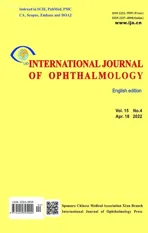Protective limb remote ischemic post-conditioning against high-intraocular-pressure-induced retinal injury in mice
2022-04-19QiJiangZhuLeiZhangShuangYuLyuZhanJunCuiEnSheJiangJunWang
INTRODUCTION
The retina is an extension of the brain tissue and also is the highest oxygen-consuming organ in the body,with high sensitivity to ischemia. Retinal ischemia can lead to functional and morphological changes culminating in blindness. Several ophthalmic diseases are related to retinal ischemia, including glaucoma, obstructive retinopathy,ischemic optic neuropathy, carotid artery occlusive disease,and diabetic retinopathy. Thus far, retinal ischemic injury is still an issue for treatment. Current neuroprotective agents offer incomplete protection, whereas others generate nonspecific effects/risks or toxicity. Therefore, safe and effective alternative therapeutic interventions are required.
LRIC was performed after completing high-IOP procedures.A tourniquet (5 mm) was tightened around the right proximal thigh for three cycles; a cycle comprised of a 5min occlusion phase and a 5min release phase. When the pulse disappeared,skin temperature in the distal limb was decreased and the skin cyanosed, indicating the femoral artery was occluded. LRIC was conducted every day thereafter. Sodium pentobarbital(30 mg/kg) was intraperitoneally applied before LRIC treatment. The same dose of pentobarbital dose was used to treat the sham or control group.
All data were expressed as the mean±standard error of the mean (SEM). Differences among groups were statistically analyzed using one-way ANOVA. A0.05 value was considered statistically significant. Statistical analyses were performed using Sigma Stat 3.5.
MATERIALS AND METHODS
Procedures relating to animal performance and surgery were approved by the Committee of Medical Ethics and Welfare for Experimental Animals, Henan University School of Medicine (Ref no. MEWEAHUM 2014-0001). Strict efforts were made to reduce animal suffering in accordance with the Association for Research in Vision and Ophthalmology (ARVO) on the use of animals.
C57BL6 mice (8-12-week-old and weight range 18-28 g) were purchased from Zhengzhou University(Henan, China) and housed in individually ventilated cages.Environmental conditions were maintained over a 12h/12h light/dark cycle, with humidity at 60%±5% and temperature at 22℃±3℃. Food and water were freely accessible.Animals were initially divided randomly into three or four groups. LRIC in control animals (=18) did not affect retinal histology when compared with sham animals (sham group,=4). Subsequently, three animal groups were used. Animals undergoing high-IOP treatment in the eyeball were designated as the high-IOP group (=18). Animals undergoing high-IOP +LRIC were the high-IOP + LRIC group (=18).
原始社会生产资料公有,生产力低下,没有文字,也无学校,更无学科教学。人们的教育活动是紧密结合着人们的生产劳动和社会生活,在一种自然状态下,根据个人的需要进行一对一的个别教学。教学方法多是以讲述、问答、示范、练习为主。
The mice were anaesthetized by using a pentobarbital (100 mg/kg)intraperitoneal injection, and 0.5% proparacaine hydrochloride was used as topical anesthesia in the cornea. Next, 1%tropicamide was applied externally applied onto the cornea to dilate the pupils. Anaesthetized mice were laid down on their left side under a stereo microscope. A 30-gauge needle connected to an NS bag was inserted horizontally into the anterior chamber of the right eye. Then, the bag was raised to approximately 150 cm. When the anterior segment of the globe got whitening (vessels were blocked), ischemia conditioning could be complete. The high-IOP was then maintained for 50min and, then returned to normal-IOP by removing the needle. Usually, the whitened anterior eyeball was restored with blood supply. For the sham group, a needle was inserted into the cornea but without elevated IOP. Eyeballs and retinas were collected for analysis at 1, 3, and 7d post high-IOP.
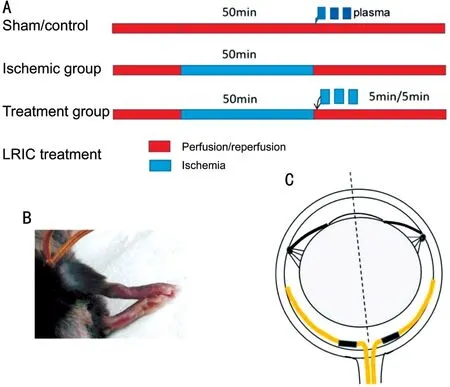
Ischemic conditioning was initially discovered by Murry. Later, it was used to intermittently block remote organs(, limbs) which were relatively ischemia-tolerant. We refer to this as limb remote ischemic post-conditioning (LRIC).Ischemic conditioning may be divided into pre-, per-, and postconditioning types. Since retinal ischemia onset is usually unpredictable, we used limb ischemic post-conditioning as a clinical strategy. In recent years, extensive research has shown that LRIC has been comprehensively developed from a basic research tool to a complex clinical technique, with its application potential constantly evolving. LRIC as a safe(non-invasive), economical, and effective adjuvant intervention has provided protective roles towards the heart, brain, lung,kidney, liver, and intestine. The retina is the most important tissue in the eye and extends from the central nervous system.In terms of increased oxygen consumption and metabolic activity, the retina is more sensitive to hypoxia and ischemia.However, LRIC-based treatment studies on retinal ischemic injury are limited. Zhangreported that middle cerebral and pterygopalatine artery occlusion induced retinal ischemic injury, and was ameliorated by an LRIC intervention. In our study, we investigated the role of LRIC on high intraocular pressure (IOP)-induced retinal ischemia injury in mice, which is a commonly used animal model without large surgery stress. Also, the pathological process is closer to real ischemia conditions. Furthermore, we assessed if plasma aliquots from LRIC-treated animals could induce protective effects on retinal ischemic injury. We sought to identify possible endogenous humoral molecules released into the circulation to promote LRIC-protective effects. This work provides a research basis for exploring effective molecules induced by LRIC (Figure 1).
Mouse plasma from LRIC (5 min occlusion/5 min release over three cycles) treated animals (30min later) was collected by intracardiac bleeding.Blood collected in anticoagulation tubes was used to prepare plasma by centrifugation at 1000 g. Plasma aliquots were stored at -80℃. Plasma was then systemically intravenously injected (150 μL/injection) into micethe tail.
合理配比原材料,也能够避免发生裂缝现象。其中,混凝土强度等级与原材料的配比是否准确息息相关,其会直接引起混凝土结构出现一定的变动,因此在实际施工前,必须根据现场施工条件和情况,对混凝土配比进行科学、合理地设计,保证参数符合施工要求。除此之外,在一些路桥施工过程中,由于受原材料、环境及施工企业等影响,导致实际情况与规划出现一定的偏差,这就需要施工企业在施工过程中通过具体施工情况对原材料配比进行有效的优化。
Malondialdehyde (MDA) levels and super oxide dismutase (SOD) enzyme activities were measured by commercial assay kits (Nanjing Jiancheng Bioengineering Institute, Nanjing, China).
Retinas were rapidly isolated from eyeballs with pigmentary epithelium discarded. After this, retinal tissues were homogenized in RIPA buffer (Beyotime, China). Protein samples were separated by 10% sodium dodecyl sulfate polyacrylamide gel electrophoresis and gels transferred to nitrocellulose membranes (Millipore, MA, USA). These were blocked in 3% bovine serum albumen and incubated overnight at 4℃ with primary antibodies (CHOP, Beyotime,1:2000;Iba-1, Abcam, 1:5000; caspase 9, Boster, 1:1000). The next day, a secondary antibody (horseradish peroxidase-conjugated goat anti-rabbit) was added and incubated for 1h at room temperature on a shaker. Protein band optical densities were semi-quantitatively measured by Image J v2.1. β-actin (1:400,Boster) was used as a loading control.
Horizontal retinal paraffin-embedded slides (5 μm in thickness around the optic disc) were deparaffinized in xylene and rehydrated in decreasing ethanol concentrations. Retinal sections were stained by hematoxylin and eosin. To examine retinal thickness, three measurements were averaged for each retina from the peripheral to the center. For immunofluorescence staining, retinal sections were washed in 0.01 mol/L phosphate buffered saline (PBS, pH 7.4) and incubated with antigen retrieval buffer (Boster, China) according to manufacturer's instructions. After this, sections were blocked in 10% normal goat serum (Boster, China) for 30min and incubated overnight at 4℃ with primary antibodies (anti-NeuN 1:400, Boster,China; anti-Iba-1, 1:1000, Abcam, USA, and anti-CHOP 1:1000, Beyotime, China; and anti-caspase 9 1:100, Boster,China). The following day, after washing with PBS, sections were incubated with relevant secondary antibodies (1:500,Beyotime) for 1h at room temperature. After washing twice in PBS (5min each), section images were observed using an optical or fluorescence microscope. For dihydroethidium(DHE) staining, eyeballs were embedded into compound tissue-tek (SaKura Finetec, USA) and fixed in liquid nitrogen.Retinal cryosections (5 μm) were incubated with DHE(40min at room temperature). Images were observed under a fluorescence microscope and the fluorescence intensity was then calculated.
骨髓抑制是细胞毒化疗药物的常见不良反应之一,是大多细胞毒药物的剂量限制性毒性。化疗药物种类、剂量强度、白蛋白、肾功能、既往化疗放疗等是影响骨髓抑制的重要因素[2]。本组患者发生Ⅳ度骨髓抑制大多为既往接受过多次化疗或放疗,共99例/次(75.3%),此类患者机体骨髓储备能力降低,比既往未接受放化疗患者更易发生Ⅳ度骨髓抑制。出现Ⅳ度骨髓抑制时若不予以积极干预,不仅影响化疗方案的实施及临床治疗效果,甚至引起严重感染、贫血、出血及心力衰竭等并发症,相前研究表明与Ⅳ度骨髓抑制有关的治疗相关性病死率达4%-12%[3]。
然而,该方法仍存在一定的缺陷:对于体积较大的BPH,由于前列腺侧叶表面黏膜切开范围相对较大,而腺体尿道黏膜血供较丰富,切开时容易使出血较多,造成视野不清,进而延长手术时间。本研究用小能量高频率的激光(1.5 J/50 Hz)可在一定程度上改善止血效果。此外,过大的前列腺尖部区域往往超过一个镜野,初学者手术经验欠缺,不易准确判断黏膜切开线的位置,也使该方法的应用范围受到了一定的限制。
RESULTS
To explore whether endogenous protective molecules induced by LRIC exerted remote protective effects against retinal ischemic injury, LRIC-treated plasma was transfused into high-IOP animals. Our results indicated that application of LRIC-treated plasma appeared to inhibit high-IOP-induced increase of caspase 9, a key apoptosis enzyme (Figure 6). Furthermore, we also evaluated reaction oxygen species (ROS) levels in retina tissue, by using a ROS fluorescent DHE probe. The results showed that LRIC treatedplasma inhibited the enhanced ROS fluorescence intensity induced by high-IOP (<0.05; Figure 7). Taken together, LRIC treated-plasma may exert protective effects in high-IOP retinas through anti-apoptosis and anti-oxidative stress. The effective endogenous component maybe came from the endocrine of LRIC treated limb.
CHOP is an endoplasmic reticulum stress marker.Western blotting and immunohistochemical staining analysis indicated that high-IOP induced increases in CHOP expression could be inhibited by LRIC treatment (<0.05; Figure 4A,4B). MDA levels and superoxide dismutase (SOD) activities were evaluated as oxidative stress markers. As shown (Figure 4C, 4D), MDA levels were increased, whereas SOD activity was significantly decreased at day 1 after high-IOP (<0.05).In contrast, the increases in MDA levels and the decreased in SOD activities were inhibited significantly by LRIC treatment.Retinal ischemic injury usually lead to strong microglia activation.Immunohistochemical staining (Figure 5A) and Western blot analyses (Figure 5B) were used to evaluate Iba-1 expression(a microglia and macrophage marker). Our data indicated that low Iba-1 levels were detected in the normal retina. However,at 1d after high-IOP, Iba-1 levels were abundantly expressed in the ganglion cell layer and inner plexiform layer. However, in the high-IOP + LRIC group, increased Iba-1 levels induced by high-IOP were significantly reduced when compared with the high-IOP group (<0.05; Figure 5).
To evaluate the effects of plasma based endogenous factors induced by LRIC, the animals were divided into control(=12), high-IOP + normal saline (NS) group (=12), and high-IOP + plasma (=12) groups. The right eye was typically chosen to perform for high IOP procedures.
LRIC treatment in the normal animals did not affect retinal histomorphology. Thus, the sham group and LRIC control group were combined as the control group subsequently. In the high-IOP group, retina cross-sections were disorganized, edema and thickened 1d after application of high-IOP (Figure 2A). In the 7day after high-IOP, whole retina thickness and inner plexiform layers were significantly decreased since loss of neurons (Figure 2B). These histological changes induced by high-IOP were relieved by the LRIC treatment significantly (<0.05; Figure 2). Immunofluorescence staining for neuN in retinal cross-sections revealed the positive signals were neuron cells (Figure 3). Significant neuronal loss in the ganglion cell layer was observed 7d after high-IOP, however,this loss was remarkably inhibited by LRIC (<0.05). These data suggested LRIC may have protected the retina against high-IOP induced injury.


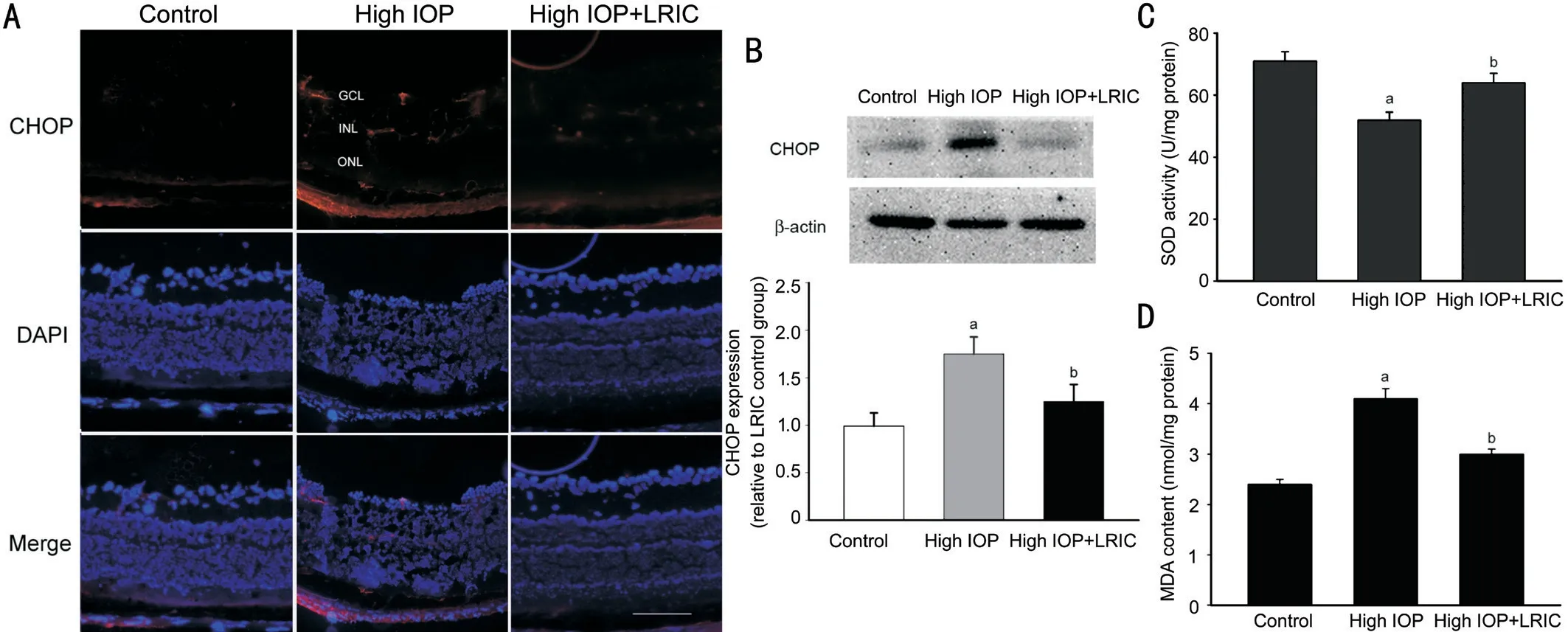
DISCUSSION
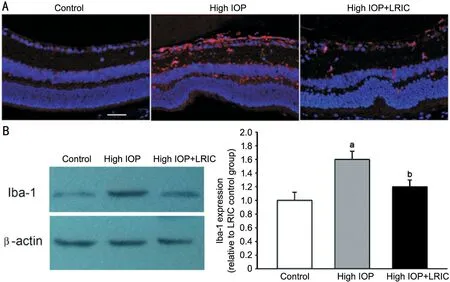
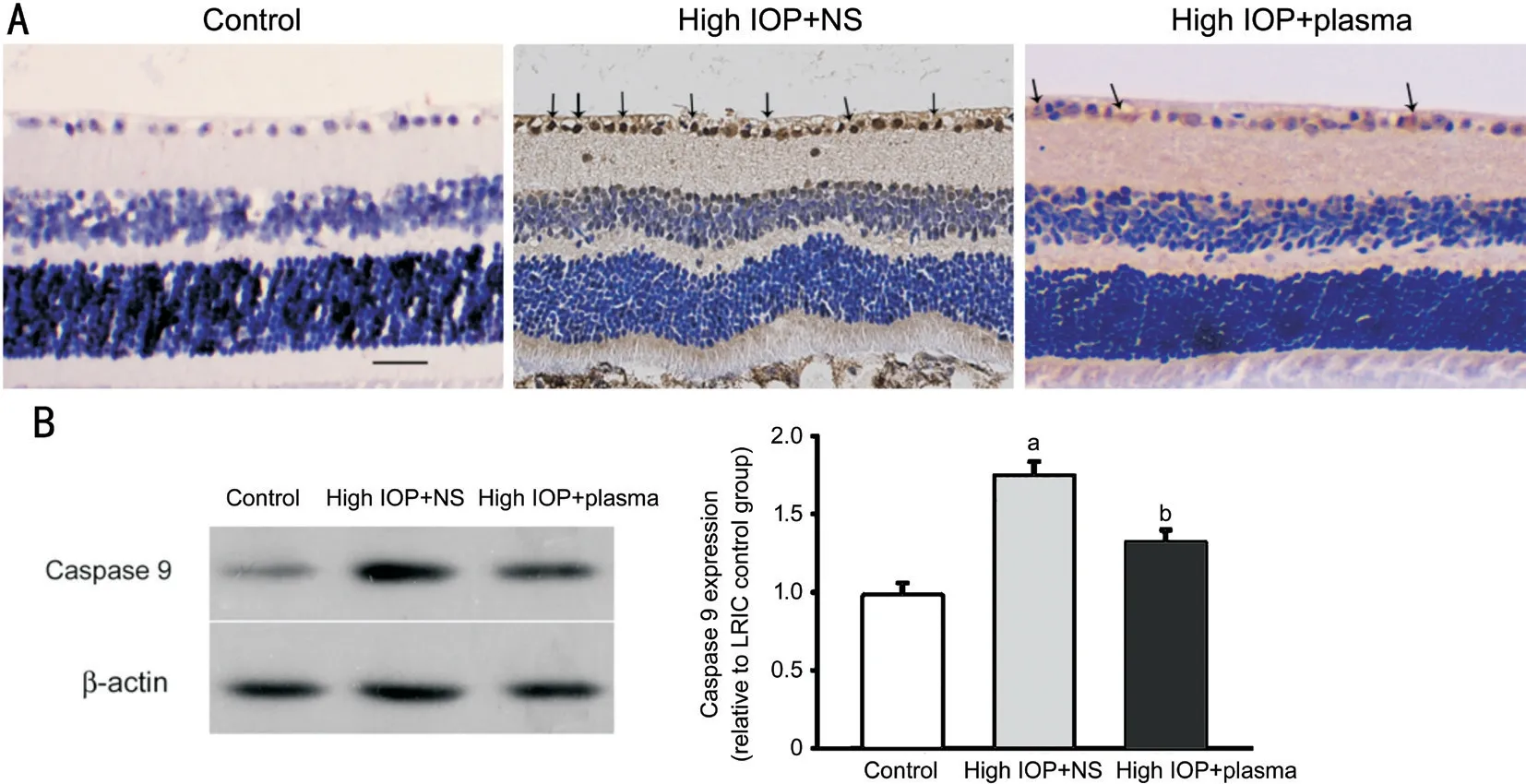
Our study suggested that LRIC generated retinal protective roles against high-IOP induced injury through the inhibition of CHOP, Iba-1 and oxidative stress levels. In addition, we observed that LRIC-treated plasma decreased caspase-9 levels and ROS formation in high-IOP retinas. Thus, endogenous factors induced by LRIC may release into the circulatory system and exerted remote protective roles.LRIC is a potent endogenous protection system which potentially triggers a series of endogenously active biological factors to exert protective effects against retinal ischemic injury. It applies intermittent blood flow blocking to an organ (typically the limbs) which in turns exerts protective roles toward the organ experiencing ischemic injury. Typically, three LRIC approaches are available (pre-, per- and post-conditioning)for practical applications. In reality, ischemic events cannot be predicted, therefore, post-conditioning may be considered a therapeutic intervention for multi-organ protection. A previous study reported that LRIC exerted protective roles against cerebral artery occlusion induced by retinal ischemia injury. Our study revealed that high-IOP in a mouse model treated with LRIC induced retinal protection. The surgical approach generating high-IOP was less invasive than other vascular occlusion surgery, therefore it may be more practical for exploring underlying LRIC mechanisms. High IOPinduced retinal ischemia is commonly used to generate retinal ischemic reperfusion in mouse models. Because the mouse lens is relatively larger than humans, it is easier to oppress backwards and induce acute ischemia under acute ocular hypertension conditions. The mouse model reflects the same pathological changes as seen in human conditions, including acute angle-closure glaucoma and retinal vessel occlusion.Similar to previous investigations, high-IOP stress led to changes in retinal histology. During the preliminary stages (24h) of retinal ischemic-reperfusion injury, the main pathological changes were vacuolation, edema, and increased thickness of the ganglion cell layer, inner nuclear layer and the whole retina. In later stages (7d), retinal thickness reduced, and ganglion cell numbers decreased significantly. LRIC at 5min and 3d after reperfusion ameliorated these histological changes induced by ischemic reperfusion injury. These protective roles were consistent with previous post-conditioning mouse models.
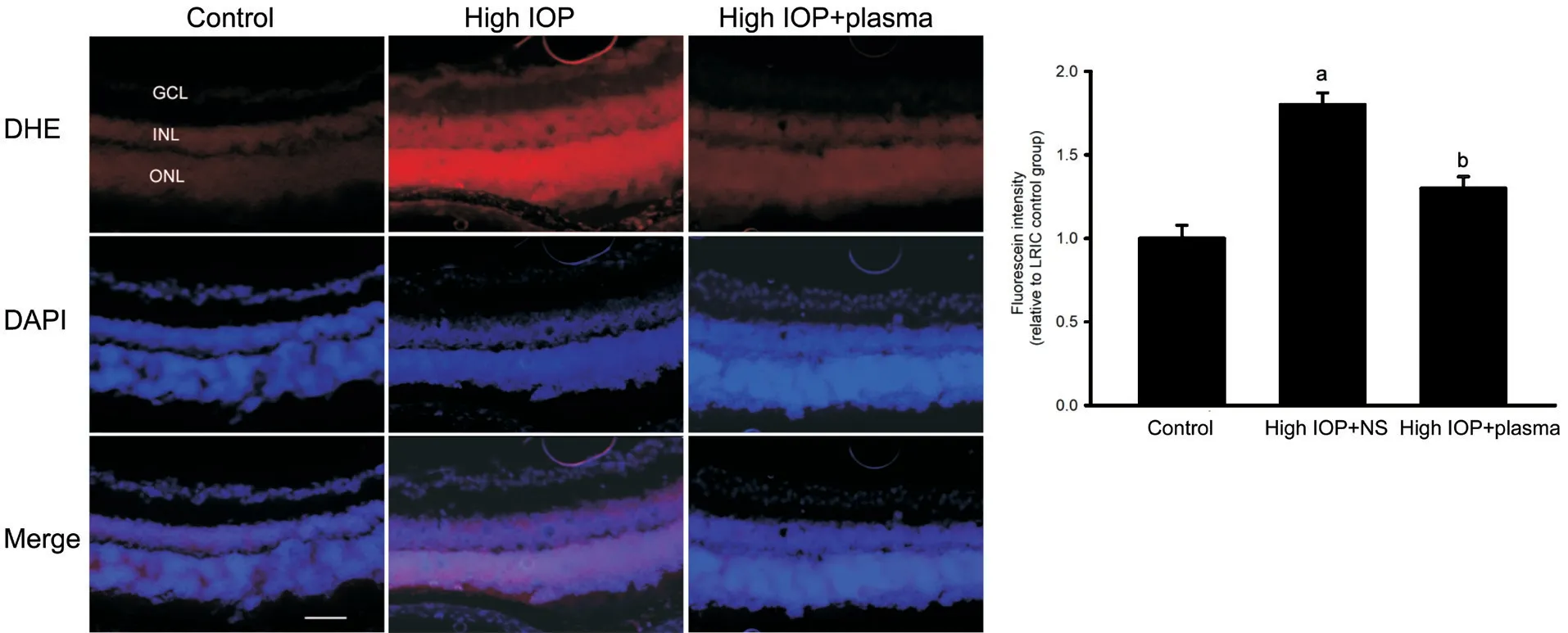
Ischemic-reperfusion injury is a main source of free radical generation, which if in excess, induce oxidative stress damage towards proteins, lipids, and nucleic acids. We showed that LRIC inhibited increased MDA levels and decreased SOD activity. MDA is a product of lipid peroxidation and is an indicator to assess oxidative stress damage and severity.Increasing evidence has identified associations between remote ischemic conditioning and antioxidant activity. CHOP is an endoplasmic reticulum (ER) stress-related protein and is used as an ER stress marker. Increased retinal CHOP levels are observed in many conditions, including ischemic reperfusion injury, diabetic retinopathy, and other diseases. ER homeostasis may be dysregulated by hypoxia, oxidative stress,and inflammation. The ER stress and oxidative stress always interact to generate apoptosis and even cause tissue injury.In our study, LRIC in ischemic reperfusion animals reduced CHOP expression, consistent with the ROS formation.
Ischemia/hypoxia induces direct retinal damage during high-IOP conditions. In addition, blood reperfusion induced leukocyte infiltration (including monocytes/macrophage)induces inflammatory response cascades which may induce more subsequent injury. Therefore, LRIC could alter these systemic responses and decrease the extent of nervous injury by decreasing leukocyte accumulation and inflammatory factor expression. Our results indicated LRIC inhibited high-IOP induced Iba-1 expression in the retina, which was in accord with previous report. Iba-1 is a macrophage/microglia marker.It was not very easy to distinguish Iba-1 positive microglia and infiltrated monocytesour morphology staining. From Ha'sstudy, we were aware of the Iba-1 positive staining including both types of the cellular during retinal ischemic reperfusion injury status. Thus, LRIC appeared to reduce infiltrated monocytes and microglia activation, which may contribute to retinal protection against ischemic reperfusion injury.
我院通过对2010年2月~2018年4月我院收治的56例股骨颈骨折患者进行研究,得出观察组患者的护理总有效率为96.43%,而对照组护理总有效率为64.29%,观察组患者的护理效果明显优于对照组;观察组的护理满意度为100%,明显高于对照组的护理满意度(60.71%%),组间差异明显,差异有统计学意义(P<0.05)。
(2)抗风险能力不足。湖北省零部件产业虽然规模较大,但产业中单个企业的规模普遍较小,在投资力度、技术水平方面均相对落后,而且生产的产品以劳动密集型为主,具有技术含量的产品较少,具有自主品牌和核心竞争力的产品不足,因此在对整车供应中并不占优势,这将导致企业利润被挤压,由此影响汽车零部件产业的抗风险能力。
Plasma transfusion are effective interventional methods and have been demonstrated for several disease conditions including cardioprotection, severe sepsis, Alzheimer's disease,and age related impairment. In our study, LRIC plasma was transfused into high-IOP animals, and showed that the apoptotic signal enzyme, caspase 9 and ROS formation in retinas were significantly reduced. Studies have reported that remote ischemic condition protection is generated by the release of multiple humoral factors into the circulation,including heat shock proteins, extracellular vesicles,adenosine, nitric oxide, and glutamate. Thus, we also preliminarily verified the protective effects of LRICtreated plasma by intravenous injection. Further research is required to fully clarify the essential humoral factors required for LRIC protection and related neuroregulatory mechanisms.In conclusion, since remote ischemic condition was proposed in 1986, extensive research and clinical transformational studies have emerged. We demonstrated that LRIC protected high IOP-induced retinal injuryantioxidant and ER stress inhibition. Reduced monocyte infiltration and microglia activation may have played an important role in this protection. The present study demonstrated that LRICplasma transfusion exerted protective effects from ischemic reperfusion injury by inhibiting caspase 9 and ROS production in high-IOP animals. However, LIRC humoral or/and neural mechanisms require further investigation, therefore, future studies need to determine and identify key factors released into the circulation. Ultimately, this effective, low cost, low risk therapy could be optimally developed for improved applications in clinical medicine.
三是围绕变化环境下的风险规避与防灾减灾,积极为极端和突发水事件的应急响应提供有效支撑。10年来,适应全球气候变化和经济社会快速发展导致的极端和突发水事件频发的情势需求,水利科技创新突破,在应对汶川特大地震、舟曲泥石流和玉树地震等自然灾害的过程中,对堰塞湖处置、灾情判别和水情预报、饮用水应急处理、城乡供水恢复、水工程安全评估与除险等防灾减灾救灾中起到了基础性科技支撑作用。
Zhu QJ and Wang J designed,performed the experiments and drafted the manuscript; Zhang L, Lyu SY, and Cui ZJ analysed part of the data, provided some technical guidance for experiment; Jiang ES provided intellectual input, supervised the research and edited the manuscript. All authors reviewed and approved the final manuscript for submission.
Supported by the National Natural Science Foundation of China (No.31300884; No.81803573).None;None;None;None;None;None.
猜你喜欢
杂志排行
International Journal of Ophthalmology的其它文章
- Leptin activates the JAK/STAT pathway to promote angiogenesis in RF/6A cells in vitro
- CCPG1 involved in corneal Aspergillus fumigatus infection
- Anti-scarring effect of sodium hyaluronate at filtration pathway after filtering surgery in rabbits
- Five-in-one: a novel, cost-effective yet simple use of micro needle holder
- CO2 laser-assisted sclerectomy surgery and trabeculectomy combination therapy in Peters’ anomalyrelated glaucoma: a case report
- Congenital fibrovascular pupillary membranes: case series with pathological correlation and surgical treatment
